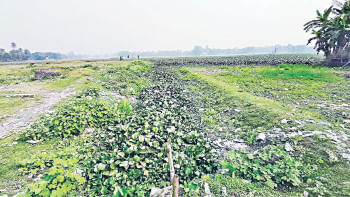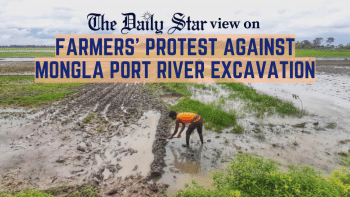Can we reimagine rivers before it is too late?

Bangladesh is born of water. The major part of Bangladesh lies in the GBM Delta, which is a confluence of three mighty rivers – Ganga, Brahmaputra and Meghna. The silt carried by these rivers and their numerous branches have formed most of the landmass of Bangladesh, and currently, the country is gaining 20 square kilometres annually through this process. The rivers are not only our past but also our future. Unfortunately, the rivers no longer have a place in our national imagination. That's why 90 percent of rivers are being occupied and polluted; over the past 20 years (2000 to 2020), more than 43 rivers have dried up. Riverine Bangladesh has become the land of dying rivers. Isn't it a tragic irony?
How did we get here? It is well documented that a progressive river management system, maintained by the community with the support of the state, was active in Bengal, which brought her the fame of being the "paradise of nations". However, the chaos following the decline of the Mughal Empire and the advent of British colonial rule disarrayed those indigenous practices. The colonists had the image of peaceful and calm British rivers and, therefore, while dealing with the rough waters in Bengal, they tried to control them. Their arrogance and ignorance led them to undertake projects that proved fatal to the rivers in Bengal. The road-railway network in Bengal, for example, was built in the east-west direction instead of aligning it with the southward course of rivers, and, thus, the natural courses of the rivers were seriously disrupted.
The British left the country, but the colonial legacy remained. The Pakistan government undertook development projects that proved disastrous to the rivers. The Kaptai Hydroelectric Project, for example, on the River Karnaphuli not only damaged the river but also displaced thousands of people who are still suffering from that trauma.
Unfortunately, in independent Bangladesh, we are still obsessed with the idea of development that is apathetic to nature. One recent example is the all-weather road in Kishoreganj. The 29.73 kilometre road was built in the middle of the haor without carrying out a proper environmental survey. Two years into its existence, the road is now causing serious damage to the crops and exacerbating the flood situation by disrupting the free flow of water.
Bangladesh has been spending a significant portion (around 20 percent) of the national budget annually on water development projects since independence, but the water problem in the country is worsening day by day. On the one hand, more and more rivers are losing streams and dying, and on the other hand, the severity of floods is increasing year after year.

We have failed to understand that it doesn't matter what percentage of the country's GDP is spent on maintaining rivers unless and until rivers are considered the driving force of development. History shows that the prosperity of Bengal was led by trade, not by agriculture. Bengal's intricate river network connecting to sea routes afforded her the opportunity of participating in robust internal and external trade and commerce, and important trade centres developed along the river routes. Since rivers were the lifelines of that time, they were revered and properly maintained. Can we now reimagine a prosperous riverine Bangladesh where rivers will be at the centre of all our plans?
The most important question is who will lead us in this effort. Here, we can learn from the example of Bhabadaha. The permanent polders built around the beels in Bhabadaha between 1965 and 1969 using USAID funding resulted in one of the worst waterlogging problems in Bangladesh, from which thousands of people of the area are still suffering for the last 30 years. Earlier, there used to be an Oshtomashi Baadh that would remain functional for eight months of the year to protect crops from high tide. During the monsoon, it would be cut down to let the tide come in and build land through deposition of silts. The permanent polders interfered with this natural process, thus creating a waterlogging crisis during monsoon.
To deal with this, the locals proposed a solution in the form of Tidal River Management (TRM), based on their traditional knowledge and wisdom. Still, the government and engineers of the Water Development Board were against it. However, the local people implemented TRM near Chuknagar, Khulna and found positive results, which forced the government to accept it as a technical solution to the waterlogging problem. But again, local influentials involved in the shrimp business and members of parliament, in collusion with the government, frustrated the local people, and the problem is continuing to date.
There are many such examples in Bangladesh where the state not only failed to protect the rivers but abetted the river polluters and grabbers. It is clear the responsibility of protecting and maintaining rivers must be in the hands of the community, with the state only facilitating that process.
National Professor Abdur Razzaq, in his "Bangladesh: State of the nation" lecture, pointed out that we, Bangladeshis, don't have any distinct features from our neighbours that distinguish ourselves as a separate nation – except the will to be a nation. There is every reason to imagine ourselves as a riverine nation, except the will to do so. Can we create that national will?
Shamsuddoza Sajen is a journalist and researcher.

 For all latest news, follow The Daily Star's Google News channel.
For all latest news, follow The Daily Star's Google News channel. 






Comments